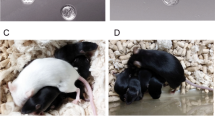Abstract
When intracytoplasmic sperm injection (ICSI) is performed in mice, isolation of sperm heads is usually performed prior to injections in order to increase the efficiency of the procedure. Consequently, the isolated sperm heads undergo an inevitable incubation in vitro. However, little is known about the effects of this incubation step on fertilization and embryo development following ICSI. When we incubated sperm heads at 37 °C, there was a significant time-dependent decrease in fertilization and blastocyst formation. Moreover, the DNA integrity of the sperm heads was maintained over 12 h incubation. Using assisted oocyte activation, these defects in fertilization and embryo development were rescued. Taken together, incubation of sperm heads following isolation can affect the oocyte-activating capacity of sperm thereby compromising fertilization and embryo development associated with ICSI.


Similar content being viewed by others
References
Bungum M, Humaidan P, Spano M, Jepson K, Bungum L, Giwercman A (2004) The predictive value of sperm chromatin structure assay (SCSA) parameters for the outcome of intrauterine insemination, IVF and ICSI. Hum Reprod 19:1401–1408
Ducibella T, Fissore R (2008) The roles of Ca2+, downstream protein kinases, and oscillatory signaling in regulating fertilization and the activation of development. Dev Biol 315:257–279
Huang CC, Lin DP, Tsao HM, Cheng TC, Liu CH, Lee MS (2005) Sperm DNA fragmentation negatively correlates with velocity and fertilization rates but might not affect pregnancy rates. Fertil Steril 84:130–140
Kashir J, Jones C, Coward K (2012) Calcium oscillations, oocyte activation, and phospholipase C zeta. Adv Exp Med Biol 740:1095–1121
Kouchi Z, Fukami K, Shikano T, Oda S, Nakamura Y, Takenawa T, Miyazaki S (2004) Recombinant phospholipase Czeta has high Ca2+ sensitivity and induces Ca2+ oscillations in mouse eggs. J Biol Chem 279:10408–10412
Kuretake S, Kimura Y, Hoshi K, Yanagimachi R (1996) Fertilization and development of mouse oocytes injected with isolated sperm heads. Biol Reprod 55:789–795
Lyu QF, Deng L, Xue SG, Cao SF, Liu XY, Jin W, Wu LQ, Kuang YP (2010) New technique for mouse oocyte injection via a modified holding pipette. Reprod Biomed Online 21:663–666
Morozumi K, Shikano T, Miyazaki S, Yanagimachi R (2006) Simultaneous removal of sperm plasma membrane and acrosome before intracytoplasmic sperm injection improves oocyte activation/embryonic development. Proc Natl Acad Sci USA 103:17661–17666
Nakai M, Ito J, Sato K, Noguchi J, Kaneko H, Kashiwazaki N, Kikuchi K (2011) Pre-treatment of sperm reduces success of ICSI in the pig. Reproduction 142:285–293
Nomikos M, Swann K, Lai FA (2012) Starting a new life: sperm PLC-zeta mobilizes the Ca2+ signal that induces egg activation and embryo development: an essential phospholipase C with implications for male infertility. BioEssays 34:126–134
Ogura A, Ogonuki N, Inoue K, Mochida K (2003) New microinsemination techniques for laboratory animals. Theriogenology 59:87–94
Ozil JP, Banrezes B, Toth S, Pan H, Schultz RM (2006) Ca2+ oscillatory pattern in fertilized mouse eggs affects gene expression and development to term. Dev Biol 300:534–544
Palermo G, Joris H, Devroey P, Van Steirteghem AC (1992) Pregnancies after intracytoplasmic injection of single spermatozoon into an oocyte. Lancet 340:17–18
Palermo GD, Schlegel PN, Colombero LT, Zaninovic N, Moy F, Rosenwaks Z (1996) Aggressive sperm immobilization prior to intracytoplasmic sperm injection with immature spermatozoa improves fertilization and pregnancy rates. Hum Reprod 11:1023–1029
Palermo GD, Neri QV, Monahan D, Kocent J, Rosenwaks Z (2012) Development and current applications of assisted fertilization. Fertil Steril 97:248–259
Saunders CM, Larman MG, Parrington J, Cox LJ, Royse J, Blayney LM, Swann K, Lai FA (2002) PLC zeta: a sperm-specific trigger of Ca(2+) oscillations in eggs and embryo development. Development 129:3533–3544
Van Steirteghem AC, Nagy Z, Joris H, Liu J, Staessen C, Smitz J, Wisanto A, Devroey P (1993) High fertilization and implantation rates after intracytoplasmic sperm injection. Hum Reprod 8:1061–1066
Velez de la Calle JF, Muller A, Walschaerts M, Clavere JL, Jimenez C, Wittemer C, Thonneau P (2008) Sperm deoxyribonucleic acid fragmentation as assessed by the sperm chromatin dispersion test in assisted reproductive technology programs: results of a large prospective multicenter study. Fertil Steril 90:1792–1799
Wu AT, Sutovsky P, Manandhar G, Xu W, Katayama M, Day BN, Park KW, Yi YJ, Xi YW, Prather RS et al (2007) PAWP, a sperm-specific WW domain-binding protein, promotes meiotic resumption and pronuclear development during fertilization. J Biol Chem 282:12164–12175
Yamauchi Y, Yanagimachi R, Horiuchi T (2002) Full-term development of golden hamster oocytes following intracytoplasmic sperm head injection. Biol Reprod 67:534–539
Acknowledgments
We are grateful for the financial support provided by the National Natural Foundation of China (31071275 to QF Lyu, 81270749 to YP Kuang, 31101070 to WR Chai) and the Natural Science Foundation of Shanghai, China (12ZR1416600 to Hui L, 11411950105 to YP Kuang). We also thank Yang HM and Miao CX for completing some of the experiments for this study.
Author information
Authors and Affiliations
Corresponding author
Additional information
Hui Long, Sheng-Sheng Lu and Yan-Ping Kuang contributed equally to this work.
Rights and permissions
About this article
Cite this article
Long, H., Lu, SS., Kuang, YP. et al. Incubation of sperm heads impairs fertilization and early embryo development following intracytoplasmic sperm injection (ICSI) by decreasing oocyte activation in mice. Biotechnol Lett 35, 1823–1829 (2013). https://doi.org/10.1007/s10529-013-1287-2
Received:
Accepted:
Published:
Issue Date:
DOI: https://doi.org/10.1007/s10529-013-1287-2




